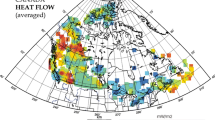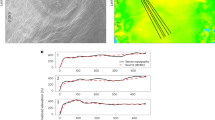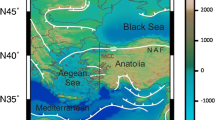Abstract
The McKenzie model proposed in 1978, which is widely used in calculating the thermal history of rift basins and other extensional basins, incorrectly assumes that all heat passing through the lithosphere originates below the lithosphere. In reality, heat from radiogenic sources within the lithosphere, especially in the upper crust, may represent more than half the heat flow at the top of basement. Thinning of the lithosphere during extension does indeed result in an increase of heat flowing from the asthenosphere, but this thinning also reduces the radiogenic heat from within the lithosphere. Because these two effects cancel to a large degree, the direct effects of lithospheric extension on heat flow at the top of basement are smaller than those predicted by the McKenzie model. Because of permanent loss of radiogenic material by lithospheric thinning, the heat flow at the top of basement long after rifting will be lower than the pre-rift heat flow.
The McKenzie model predicts an instantaneous increase in heat flow during rifting. The Morgan model proposed in 1983, however, predicts a substantial time delay in the arrival of the higher heat flow from the asthenosphere at the top of basement or within sediments. Using the Morgan model, heat flow during the early stages of rifting will actually be lower than prior to rifting, because the time delay in the loss of radiogenic heat is less than the time delay in arrival of new heat from the asthenosphere.
Similar content being viewed by others
REFERENCES
Allen, P. A., and Allen, J. R., 1990, Basin analysis principles and applications: Blackwell Scientific Publications, Oxford, 451 p.
Baxter, K., Cooper, G. T., O'Brien, G.W., Hill, K. C., and Sturrock, S., 1997, Flexural isostatic modelling as a constraint on basin evolution, the development of sediment systems and palaeoheat flow: application to the Vulcan Sub-basin, Timor Sea: APPEA Jour., v. 37, no. 1, p. 120–137.
Birch, F., Roy, R. F., and Decker, E. R., 1968, Heat flow and thermal history in New England and New York, in White, W., and Zen, E.-A. eds., Studies of Appalachian Geology: Northern and Maritime: Interscience, New York, p. 437–451.
Bodell, J. M., and Chapman, D. S., 1982, Heat flow in the northcentral Colorado Plateau: Jour. Geophys. Research, v. 87, no. B4, p. 2869–2884.
Browne, S. E., and Fairhead, J. D., 1983, Geophysical controls on sedimentation within the African rift systems, in Morgan, P., ed., Processes of Continental Rifting: Tectonophysics, v. 94, no. 1–4, p. 187–203.
Čermák, V., and Bodri, L., 1986, Temperature structure of the lithosphere based on 2-D temperature modelling, applied to Central and Eastern Europe, in Burrus, J., ed., Thermal Modeling in Sedimentary Basins: Éditions Technip, Paris, p. 7–31.
Chesley, J. T., Rudnick, R. L., and Lee, C.-T., 1999, Re-Os systematics of mantle xenoliths from the East African Rift: Age, structure, and history of the Tanzanian craton: Geochimica et Cosmochimica Acta, v. 63, no. 7/8, p. 1203–1217.
Clauser, C., 1988, Opacity—the concept of radiative thermal conductivity, in Haenel, R., Rybach, L., and Stegena, L., eds., Handbook of Terrestrial Heat-Flow Density Determination: Kluwer Acad., Amsterdam, p. 143–165.
Cochran, J. R., 1983, Effects of finite rifting times on the development of sedimentary basins: Earth and Planetary Science Letters, v. 66, p. 289–302.
Dawson, J. B., and Smith, J. V., 1988, Metasomatised and veined upper-mantle xenoliths from Pello Hill,Tasmania: evidence for anomalously-light mantle beneath the Tanzanian sector of the East African Rift Valley: Contrib. Mineralogy and Petrology, v. 100, no. 4, p. 510–527.
Deming, D., and Chapman, D. S., 1989, Thermal histories and hydrocarbon generation: example from Utah-Wyoming thrust belt: Am. Assoc. Petroleum Geologists Bull., v. 73, no. 12, p. 1455–1471.
Funnell, R., Chapman, D., Allis, R., and Armstrong, P., 1996, Thermal state of the Taranaki Basin, New Zealand: Jour. Geophys. Research, v. 101, no. B11, p. 25,197–25,215.
Furlong, K. P., and Chapman, D. S., 1987, Crustal heterogeneities and the thermal structure of the continental crust: Geophys. Research Letters, v. 14, no. 3, p. 314–317.
Guillou-Frottier, L., Mareschal, J.-C., Jaupart, C., Gariépy, C., Lapointe, R., and Bienfait, G., 1995, Heat flow variations in the Grenville Province, Canada: Earth and Planetary Science Letters, v. 136, nos. 3–4, p. 447–460.
Gupta, M. L., Sundar, A., and Sharma, S. R., 1991, Heat flow and heat generation in the Archean Dharwar cratons and implications for the Southern Indian Shield geotherm and lithospheric thickness: Tectonophysics, v. 194, no. 1, p. 107–122.
Hellinger, S. J., and Sclater, J. G., 1983, Some comments on twolayer extensional models for the evolution of sedimentary basins: Jour. Geophys. Research, v. 88, no. B10, p. 8251–8269.
Jarvis, G. T., and McKenzie, D. P., 1980, Sedimentary basin formation with finite extension rates: Earth and Planetary Science Letters, v. 48, no. 1, p. 42–52.
Jaupart, C., 1986, On the average amount and vertical distribution of radioactivity in the continental crust, in Burrus, J., ed., Thermal Modeling in Sedimentary Basins: Éditions Technip, Paris, p. 33–47.
Keen, C. E., Loncarevic, B. D., Reid, I., Woodside, J., Haworth, R. T., and Williams, H., 1990, Tectonic and geophysical overview, in Keen, M. J., and Williams, G. L., eds., Geology of the Continental Margin of Eastern Canada: Geol. Survey Canada, Geology of Canada, no. 2, p. 31–85.
Kusznir, N. J., and Park, R.G., 1987, The extensional strength of the continental lithosphere: its dependence on geothermal gradient, and crustal composition and thickness, in Coward, M. P., Dewey, J. F., and Hancock, P. L., eds., Continental Extensional Tectonics: Geol. Soc. London, Spec. Publ. no. 28, p. 35–52.
Lachenbruch, A. H., 1968, Preliminary geothermal model of the Sierra Nevada: Jour. Geophys. Research, v. 73, no. 22, p. 6977–6989.
Lee, C.-T., and Rudnick, R. L., 1999, Compositionally stratified cratonic lithosphere: petrology and geochemistry of peridotite xenoliths from the Labait Volcano, Tanzania: Proc. 7th Intern. Kimberlite Conf. (Cape Town), p. 503–521.
Lysak, S.V., 1992, Heat flow variations in continental rifts: Tectonophysics, v. 208, no. 1/3, p. 309–323.
Makhous, M., Galushkin, Y., and Lopatin, N., 1997, Burial history and kinetic modeling for hydrocarbon generation, part I: the GALO model: Am. Assoc. Petroleum Geologists Bull., v. 81, no. 10, p. 1660–1678.
Mareschal, J. C., Jaupart, C., Cheng, L. Z., Rolandone, F., Gariépy, C., Bienfait, G., Guillou-Frottier, L., and Lapointe, R., 1999, Heatflowin theTrans-Hudson Orogen of the Canadian Shield: Implications for Proterozoic continental growth: Jour. Geophys. Research, v. 104, no. B12, p. 29,007–29,024.
McKenzie, D., 1978, Some remarks on the development of sedimentary basins: Earth and Planetary Science Letters, v. 40, no. 1, p. 25–32.
McLennan, S. M., and Taylor, S. R., 1996, Heat flow and the chemical composition of continental crust: Jour. Geology, v. 104, no. 4, p. 369–377.
Moretti, I., and Pinet, B., 1987, Discrepancy between lower and upper crustal thinning, in Beaumont, C., and Tankard, A. J., eds., Sedimentary Basins and Basin-Forming Mechanisms: Can. Soc. Petroleum Geologists Mem. 12, p. 233–239.
Morgan, P., 1983, Constraints on rift thermal processes from heat flow and uplift: Tectonophysics, v. 94, no. 1–4, p. 277–298.
Mudford, B., Lundegard, P., and Lerche, I, 1995, Timing of hydrocarbon generation and accumulation in fault-bounded compartments in the Norphlet Formation, offshore Alabama: Marine and Petroleum Geology, v. 12, no. 5, p. 549–558.
Parsons, B., and Sclater, J. G., 1977, An analysis of the variation of ocean floor bathymetry and heat flow with age: Jour. Geophys. Research, v. 82, no. 5, p. 803–827.
Pinet, C., Jaupart, C., Mareschal, J.-C., Gariepy, C., Bienfait, G., and Lapointe, R., 1991, Heat flow and structure of the lithosphere in the Eastern Canadian Shield: Jour. Geophys. Research, v. 96, no. B12, p. 19,941–19,963.
Pollack, H. N., and Chapman, D. S., 1977, The flow of heat from the Earth's interior: Scientific American, v. 237, no. 2, p. 60–76.
Poort, J., van der Beek, P., and ter Voorde, M., 1998, An integrated modelling study of the central and northern Baikal rift: evidence for non-uniform lithospheric thinning: Tectonophysics, v. 291, no. 1–4, p. 101–122.
Royden, L., and Keen, C. E., 1980, Rifting process and thermal evolution of the continental margin of eastern Canada determined from subsidence curves: Earth and Planetary Science Letters, v. 51, no. 2, p. 343–361.
Royden, L., Sclater, J. G., and von Herzen, R. P., 1980, Continental margin subsidence and heat flow: important parameters in formation of petroleum hydrocarbons: Am. Assoc. Petroleum Geologists Bull., v. 64, no. 2, p. 173–187.
Ru, K., and Pigott, J. D., 1986, Episodic rifting and subsidence in the Sough China Sea: Am. Assoc. Petroleum Geologists Bull., v. 70, no. 9, p. 1136–1155.
Rudnick, R., and Nyblade, A. A., 1999. The thickness and heat production of Archean lithosphere: constraints from xenolith thermobarometry and surface heat flow—fantasy and facts, in Fei, Y., Berthka, C. B., and Mysen, B. O., eds., Mantle Petrology: Field Observations and High-Pressure Experimentation: Geochem. Soc. Spec. Publ. no. 6 (in honor of F. R. Boyd), p. 3–12.
Rudnick, R. L., McDonough, W. F., and O'Connell, R. J., 1998, Thermal structure, thickness and composition of continental lithosphere: Chem. Geology, v. 145, no. 3–4, p. 395–411.
Russell, J. K., Dipple, G. M., and Kopylova, M. G., 2001, Heat production and heat flow in the mantle lithosphere, Slave craton, Canada: Physics Earth and Planetary Interiors, v. 123, no. 1, p. 27–44.
Schull, T. J., 1988, Rift basins of interior Sudan: petroleum exploration and discovery: Am. Assoc. Petroleum Geologists Bull., v. 72, no. 10, p. 1128–1142.
Sclater, J. G., and Christie, P. A. F., 1980, Continental stretching: an explanation of the Post-Mid-Cretaceous subsidence of the Central North Sea Basin: Jour. Geophys. Research, v. 85, no. B7, p. 3711–3739.
Sclater, J. G., Jaupart, C., and Galson, D., 1980, The heat flow through oceanic and continental crust and the heat loss of the earth: Rev. Geophysics and Space Physics, v. 18, no. 1, p. 269–311.
Sclater, J. G., Royden, L., Horvath, F., Burchfiel, B. C., Semken, S., and Stegena, L., 1980, The formation of the intra-Carpathian basins as determined from subsidence data: Earth and Planetary Science Letters, v. 51, no. 1, p. 139–162.
Sleep, N. H., 1971, Thermal effects of the formation of Atlantic continental margins by continental break up: Geophys. Jour. Royal Astron. Soc. v. 24, no. 4, p. 325–350.
Steckler, M. S., 1985, Uplift and extension at the Gulf of Suez: indications of induced mantle convection: Nature, v. 317, no. 6033, p. 135–139.
Vejbæk, O. V., 1992, Geodynamic modelling of the Danish Central Trough, in Larsen, R. M., Brekke, H., Larsen, B. T., and Talleraas, E., eds., Structural and Tectonic Modelling and its Application to Petroleum Geology: NPF Spec. Publ. no. 1, Elsevier, Amsterdam, p. 1–17.
Vierbuchen, R. C., George, R. P., and Vail, P. R., 1982, A thermalmechanical model of rifting with implications for outer highs on passive continental margins, in Watkins, J. S., and Drake, C. L., eds., Studies in Continental Margin Geology:Am.Assoc. Petroleum Geologists Mem. 34, p. 765–778.
Vitorello, I., and Pollack, H. N., 1980, On the variation of continental heat flow with age and the thermal evolution of continents: Jour. Geophys. Research, v. 85, no. B2, p. 983–995.
Waples, D. W., 2002, A new model for heat flow in extensional basins: predicting radiogenic heat production: Natural Resources Research, in preparation.
Wheildon, J., Morgan, P., Williamson, K. H., Evans, T. R., and Swanberg, C. A., 1994, Heat flow in the Kenya rift zone: Tectonophysics, v. 236, no. 1–4, p. 131–149.
White, N., and McKenzie, D., 1988, Formation of the “steer's head” geometry of sedimentary basins by differential stretching of the crust and mantle: Geology, v. 16, no. 3, p. 250–253.
Zhou, S., 1996, A revised estimation of the steady-state geotherm for the continental lithosphere and its implication for mantle melting: Terra Nova, v. 8, no. 6, p. 514–524.
Ziegler, P. A., 1990, Geological atlas of Western and Central Europe 1990: Shell Internationale Petroleum Maatschappij/Elsevier, Amsterdam, 239 p.
Zorin, Yu. A., 1989, Maximum thickness of the lithosphere and heat flow of continents: Tectonophysics, v. 164, no. 2/4, p. 117–120.
Author information
Authors and Affiliations
Rights and permissions
About this article
Cite this article
Waples, D.W. A New Model for Heat Flow in Extensional Basins: Radiogenic Heat, Asthenospheric Heat, and the McKenzie Model. Natural Resources Research 10, 227–238 (2001). https://doi.org/10.1023/A:1012521309181
Issue Date:
DOI: https://doi.org/10.1023/A:1012521309181




